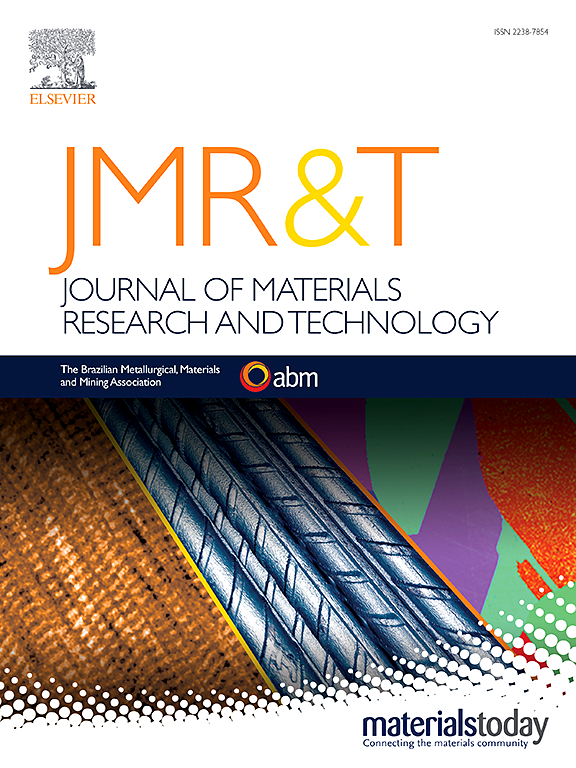高强7075铝合金多道次径向热锻组织演变及力学性能
IF 6.2
2区 材料科学
Q1 MATERIALS SCIENCE, MULTIDISCIPLINARY
Journal of Materials Research and Technology-Jmr&t
Pub Date : 2025-06-11
DOI:10.1016/j.jmrt.2025.06.070
引用次数: 0
摘要
7075铝合金具有优异的强度,但细化其显微组织和提高其机械性能是相当大的挑战。本研究对7075铝合金棒材进行了包括预热、多道次径向锻造和T6热处理在内的热径向锻造工艺。通过观察晶粒形貌(晶界、尺寸、取向)和第二相析出的变化,研究了工件边缘和核心区域的组织演化机制。工件的显微硬度和拉伸性能分别在径向锻造和T6热处理的不同固溶时间下进行了评估。结果表明,预热能显著提高工件的塑性。在多道次径向锻造过程中,细化组织的关键机制是几何动态再结晶和晶粒径向压缩及相邻晶粒间交织引起的连续动态再结晶。对径向锻件进行T6热处理有利于连续等轴亚晶的形成、细小再结晶晶粒的扩散和η′相的均匀析出。径向锻造结合T6热处理在30.6% CSRR下显著增强了工件边缘区域(极限抗拉强度[UTS]↑6.7%,伸长率↑33.3%),并改善了工件的整体机械性能(edge: UTS↑5.7%,伸长率↑32.3%;核心:UTS为4.9%,伸长率为40.4%),CSRR为55.6%。本研究可为多步7075铝合金轴提供一种快速灵活的制造工艺,可承受轻量化应用中的高载荷。本文章由计算机程序翻译,如有差异,请以英文原文为准。
Microstructure evolution and mechanical properties of high-strength 7075 aluminum alloy during multi-pass hot radial forging process
The 7075 aluminum alloy has exceptional strength, but refining its microstructure and improving its mechanical properties presents considerable challenges. In this study, a hot radial forging process comprising preheating, multi-pass radial forging, and T6 heat treatment, was implemented on 7075 aluminum alloy rods. The microstructure evolution mechanisms in the edge and core regions of the workpieces were investigated through observations on the changes in grain morphology (grain boundary, size, and orientation) and second phase precipitation. The microhardness and tensile properties of the workpiece were assessed at varying cross-section reduction rates (CSRRs) during radial forging and distinct solution durations during T6 heat treatment. Results demonstrate that preheating considerably enhances the plasticity of the workpiece. During multi-pass radial forging, the key mechanisms of refining microstructure are geometrical dynamic recrystallization and continuous dynamic recrystallization induced by the radial compression of grains and interweaving between adjacent grains. The implementation of T6 heat treatment on the radial forged workpiece facilitates the formation of continuous equiaxed subgrains, the proliferation of fine recrystallized grains and the uniform precipitation of η′ phase. Radial forging combined with T6 heat treatment considerably strengthens the edge region of the workpiece (↑6.7 % in ultimate tensile strength [UTS], ↑33.3 % in elongation) at 30.6 % CSRR, and improves the overall mechanical performance of the workpiece (Edge: ↑5.7 % in UTS, ↑32.3 % in elongation; Core: ↑4.9 % in UTS, ↑40.4 % in elongation) at 55.6 % CSRR. This study may provide an expeditious and flexible manufacturing process for multi-step 7075 aluminum alloy shafts that withstand high loads in lightweighting applications.
求助全文
通过发布文献求助,成功后即可免费获取论文全文。
去求助
来源期刊

Journal of Materials Research and Technology-Jmr&t
Materials Science-Metals and Alloys
CiteScore
8.80
自引率
9.40%
发文量
1877
审稿时长
35 days
期刊介绍:
The Journal of Materials Research and Technology is a publication of ABM - Brazilian Metallurgical, Materials and Mining Association - and publishes four issues per year also with a free version online (www.jmrt.com.br). The journal provides an international medium for the publication of theoretical and experimental studies related to Metallurgy, Materials and Minerals research and technology. Appropriate submissions to the Journal of Materials Research and Technology should include scientific and/or engineering factors which affect processes and products in the Metallurgy, Materials and Mining areas.
 求助内容:
求助内容: 应助结果提醒方式:
应助结果提醒方式:


